
TRMS Digital Multimeter
User Manual
PRECAUTIONS AND SAFETY MEASURES
The instrument has been designed in compliance with directive IEC/EN61010-1 relevant to electronic measuring instruments. For your safety and in order to prevent damaging the instrument, please carefully follow the procedures described in this manual and read all notes preceded by symbol ![]() with the utmost attention. Before and after carrying out measurements, carefully observe the following instructions:
with the utmost attention. Before and after carrying out measurements, carefully observe the following instructions:
- Do not carry out any measurements in humid environments.
- Do not carry out any measurements in case gas, explosive materials or flammables are present, or in dusty environments.
- Avoid any contact with the circuit being measured if no measurements are being carried out.
- Avoid any contact with exposed metal parts, with unused measuring probes, circuits, etc.
- Do not carry out any measurement in case you find anomalies in the instrument such as deformation, breaks, substance leaks, absence of display on the screen, etc.
- Pay special attention when measuring voltages higher than 20V, since risk of electrical shock exists.
In this manual, and on the instrument, the following symbols are used:![]() Warning: observe the instructions given in this manual; improper use could damage the instrument or its components.
Warning: observe the instructions given in this manual; improper use could damage the instrument or its components.![]() Double-insulated meter
Double-insulated meter![]() AC voltage or current
AC voltage or current![]() DC voltage or current
DC voltage or current![]() Connection to earth
Connection to earth
1.1. PRELIMINARY INSTRUCTIONS
- This instrument has been designed for use in environments of pollution degree 2.
- It can be used for VOLTAGE and CURRENT measurements on installations with CAT IV 600V and CAT III 1000V.
- We recommend following the normal safety rules devised by the procedures for carrying out operations on live systems and using the prescribed PPE to protect the user against dangerous currents and the instrument against incorrect use.
- In case the lack of indication of the presence of voltage may represent a danger for the operator, always carry out a continuity measurement before carrying out the measurement on the live system, in order to confirm the correct connection and condition of the leads.
- Only the leads supplied with the instrument guarantee compliance with the safety standards. They must be in good condition and be replaced with identical models, when necessary.
- Do not test circuits exceeding the specified voltage limits.
- Do not perform any test under environmental conditions exceeding the limits indicated in § 6.2.1.
- Check that the battery is correctly inserted.
- Make sure that the LCD display and the rotary switch indicate the same function.
1.2. DURING USE
Please carefully read the following recommendations and instructions:![]() CAUTION
CAUTION
Failure to comply with the caution notes and/or instructions may damage the instrument and/or its components or be a source of danger for the operator.
- Before activating the rotary switch, disconnect the test leads from the circuit being measured.
- When the instrument is connected to the circuit being measured, do not touch any unused terminal.
- Do not measure resistance in case external voltages are present; even if the instrument is protected, an excessive voltage may cause malfunction.
- While measuring, if the value or the sign of the quantity being measured remain unchanged, check if the HOLD function is enabled.
1.3. AFTER USE
- When the measurement is complete, set the rotary switch to OFF to turn off the instrument.
- If the instrument is not to be used for a long time, remove the batteries.
1.4. DEFINITION OF MEASUREMENT (OVERVOLTAGE) CATEGORY Standard “IEC/EN61010-1:
Safety requirements for electrical equipment for measurement, control, and laboratory use, Part 1: General requirements”, define what measurement category, commonly called overvoltage category, is. § 6.7.4: Measured circuits, reads:
(OMISSIONS)
Circuits are divided into the following measurement categories:
- Measurement category IV is for measurements performed at the source of the low voltage installation. Examples are electricity meters and measurements on primary overcurrent protection devices and ripple control units.
- Measurement category III is for measurements performed on installations inside buildings. Examples are measurements on distribution boards, circuit breakers, wiring, including cables, bus bars, junction boxes, switches, socket-outlets in the fixed installation, and equipment for industrial use and some other equipment, for example, stationary motors with a permanent connection to fixed installation.
- Measurement category II is for measurements performed on circuits directly connected to the low-voltage installation. Examples are measurements on household appliances, portable tools, and similar equipment.
- Measurement category I is for measurements performed on circuits not directly connected to MAINS. Examples are measurements on circuits not derived from MAINS and specially protected (internal) MAINS-derived circuits. In the latter case, transient stresses are variable; for that reason, the standard requires that the transient withstand capability of the equipment is made known to the user.
GENERAL DESCRIPTION
The instrument carries out the following measurements:
- DC Voltage up to 1500V
- AC TRMS Voltage up to 1000V
- DC/AC TRMS Voltage with low impedance (LoZ)
- DC/AC TRMS Current with transducer clamps
- Resistance and Continuity test
- Diode test
- Capacity
- Current and voltage frequency
- Duty Cycle
- Temperature with K-type probe
Each of these functions can be selected by means of the appropriate switch. The instrument is also equipped with function keys (see § 4.2) and backlight. The instrument is also equipped with an Auto Power OFF function (which can be disabled), which automatically switches off the instrument 15 minutes after the last time a function key was pressed or the rotary switch was turned. To switch on the instrument again, turn the rotary switch.
2.1. MEASURING AVERAGE VALUES AND TERMS VALUES
Measuring instruments of alternating quantities are divided into two big families:
- AVERAGE-VALUE meters: instruments measuring the value of the sole wave at the fundamental frequency (50 or 60 Hz).
- TRMS (True Root Mean Square) VALUE meters: instruments measuring the TRMS value of the quantity being tested.
With a perfectly sinusoidal wave, the two families of instruments provide identical results. With distorted waves, instead, the readings shall differ. Average-value meters provide the RMS value of the sole fundamental wave; TRSM meters, instead, provide the RMS value of the whole wave, including harmonics (within the bandwidth of the instrument). Therefore, by measuring the same quantity with instruments from both families, the values obtained are identical only if the wave is perfectly sinusoidal. In case it is distorted, TRMS meters shall provide higher values than the values read by average-value meters.
2.2. DEFINITION OF TRUE ROOT MEAN SQUARE VALUE AND CREST FACTOR
The root means square value of current is defined as follows: “In a time equal to a period, an alternating current with a root means the square value of 1A intensity, circulating on a resistor, dissipates the same energy that, during the same time, would be dissipated by a direct current with an intensity of 1A”. This definition results in the numeric expression:
 The root means square value is indicated with the acronym RMS. The Crest Factor is defined as the relationship between the Peak Value of a signal and its RMS value:
The root means square value is indicated with the acronym RMS. The Crest Factor is defined as the relationship between the Peak Value of a signal and its RMS value:  This value changes with the signal waveform, for a purely G RMS sinusoidal wave it is
This value changes with the signal waveform, for a purely G RMS sinusoidal wave it is  In case of distortion, the Crest Factor takes higher values as wave distortion increases.
In case of distortion, the Crest Factor takes higher values as wave distortion increases.
PREPARATION FOR USE
3.1. INITIAL CHECKS
Before shipping, the instrument has been checked from an electric as well as a mechanical point of view. All possible precautions have been taken so that the instrument is delivered undamaged. However, we recommend generally checking the instrument in order to detect possible damage suffered during transport. In case anomalies are found, immediately contact the forwarding agent. We also recommend checking that the packaging contains all components indicated in § 6.3.1. In case of discrepancy, please contact the Dealer. In case the instrument should be returned, please follow the instructions given in § 7.
3.2. INSTRUMENT POWER SUPPLY
The instrument is supplied with 1x9V alkaline battery type IEC 6F22, included in the package. When battery is flat, the symbol ” ” appears on the display. To replace the battery, see § 6.1.
3.3. STORAGE
In order to guarantee precise measurement, after a long storage time under extreme environmental conditions, wait for the instrument to come back to normal condition (see § 6.2.1).
NOMENCLATURE
4.1. DESCRIPTION OF THE INSTRUMENT
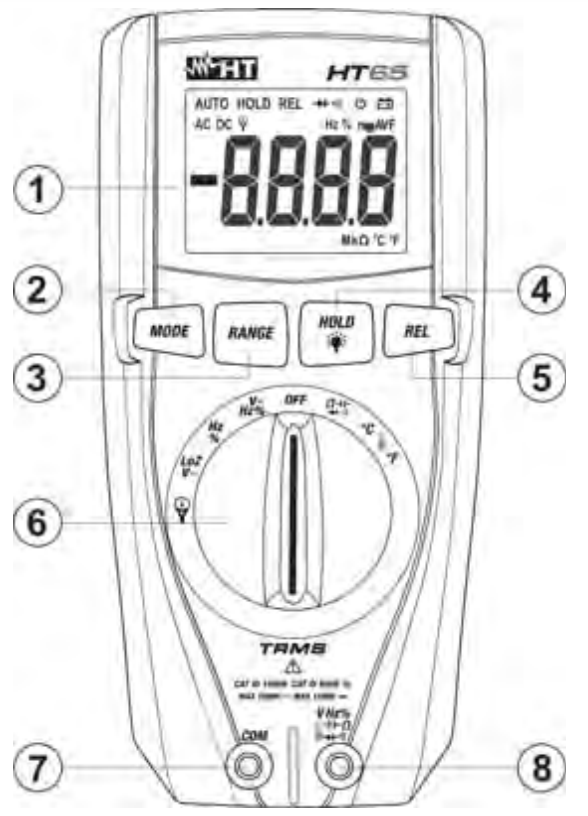
Fig. 1: Description of the instrument
CAPTION:
- LCD display
- MODE key
- RANGE key
- HOLD/
 key
key - REL key
- Rotary selector switch
- Input terminal COM
- Input terminal

4.2. DESCRIPTION OF FUNCTION KEYS
4.2.1. HOLD/ key
key
Pressing the HOLD/  key freezes the value of the measured quantity on the display. After pressing this key, the message “HOLD” appears on the display. Press the HOLD/ key again to exit the function. Press and hold the same key for longer than one second to activate and deactivate the display’s backlight. This function is active in any position of the rotary switch.
key freezes the value of the measured quantity on the display. After pressing this key, the message “HOLD” appears on the display. Press the HOLD/ key again to exit the function. Press and hold the same key for longer than one second to activate and deactivate the display’s backlight. This function is active in any position of the rotary switch.
4.2.2. RANGE key
Press the RANGE key to activate the manual mode and to disable the Auto range function. The symbol “AUTO” disappears from the upper left part of the display. In manual mode, press the RANGE key to change the measuring range: the relevant decimal point will change its position. The RANGE key is not active in positions  In Auto range mode, the instrument selects the most appropriate ratio for carrying out the measurement. If a reading is higher than the maximum measurable value, the indication “O.L” appears on the display. Press and hold the RANGE key for more than 1 second to exit the manual mode and restore the Auto range mode.
In Auto range mode, the instrument selects the most appropriate ratio for carrying out the measurement. If a reading is higher than the maximum measurable value, the indication “O.L” appears on the display. Press and hold the RANGE key for more than 1 second to exit the manual mode and restore the Auto range mode.
4.2.3. REL key
Press the REL key to activate relative measurement. The instrument zeroes the display and saves the displayed value as a reference value to which subsequent measurements will be referred to. The symbol “REL” appears on the display. This function is not active in position,  and
and °C°F. Press the key again to exit the function.
°C°F. Press the key again to exit the function.
4.2.4. MODE key
Pressing the MODE key allows selecting a double function on the rotary switch. In particular, it is active in position: to select diode test, continuity test, capacitance measurement and resistance measurement, in position 
4.2.5) and to select AC or DC measurements.
In position  , pressing the MODE key activates/deactivates the frequency (Hz) or duty cycle (%) measurements of electronic signals (different respect the same of V
, pressing the MODE key activates/deactivates the frequency (Hz) or duty cycle (%) measurements of electronic signals (different respect the same of V  position)
position)
4.2.5. LoZ feature
This model permits to performance of the AC/DC voltage measurement with a low input impedance in way to avoid the wrong readings due to stray voltage in capacitive coupled.![]() CAUTION
CAUTION![]() Inserting the instrument between phase and ground conductors, the RCDs protection devices can be tripping out during the test. For phase-PE voltage measurement after a RCD device preliminarily connect the test leads between phase and neutral cables at least for 5s, then perform the phase measurement to avoid unexpected trips-out.
Inserting the instrument between phase and ground conductors, the RCDs protection devices can be tripping out during the test. For phase-PE voltage measurement after a RCD device preliminarily connect the test leads between phase and neutral cables at least for 5s, then perform the phase measurement to avoid unexpected trips-out.
4.2.6. Disabling the Auto Power Off function
In order to preserve internal batteries, the instrument switches off automatically approximately 15 minutes after it was last used. To disable the Auto Power Off function, proceed as follows:
- Switch off the instrument (OFF) ¾
- Press and hold the MODE key and switch on the instrument by turning the rotary switch.
The instrument emits quick sounds and the ” ” symbol disappears on the display.
- Switch off and then on again the instrument to enable the function.
OPERATING INSTRUCTIONS
5.1. DC VOLTAGE MEASUREMENT![]() CAUTION
CAUTION
- The maximum input DC voltage is 1500V. Do not measure voltages exceeding the limits given in this manual. Exceeding voltage limits could result in electrical shocks to the user and damage to the instrument
- The CAT III 1000V mark on test leads guarantees a safe measurement of voltage up to 1500V

Fig. 2: Use of the instrument for DC Voltage measurement
- Select positions

- Press the MODE key to display the “DC” symbol on the display
- Insert the red cable into the input terminal
 : and the black cable into the input terminal COM.
: and the black cable into the input terminal COM. - Position the red lead and the black lead respectively in the spots with the positive and negative potential of the circuit to be measured (see Fig. 2). The display shows the value of voltage.
- If the display shows the message “OL”, select a higher range
- When the symbol “-” appears on the instrument’s display, it means that voltage has the opposite direction with respect to the connection in Fig. 2.
- To use the HOLD, RANGE, and REL functions, see § 4.2
5.2. AC VOLTAGE MEASUREMENT![]() CAUTION
CAUTION
The maximum input AC voltage is 1000V. Do not measure voltages exceeding the limits given in this manual. Exceeding voltage limits could result in electrical shocks to the user and damage to the instrument.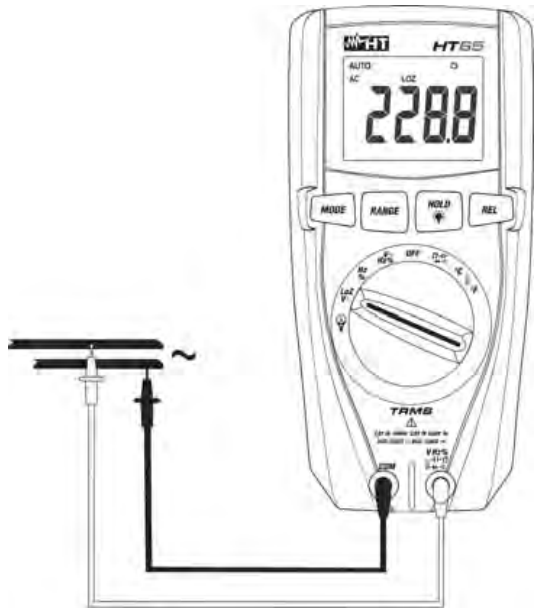
Fig. 3: Use of the instrument for AC voltage measurement
- Select positions

- Insert the red cable into the input terminal
 terminal COM. and the black cable into input
terminal COM. and the black cable into input - Position the red lead and the black lead respectively in the spots of the circuit to be measured (see Fig. 3). The display shows the value of voltage.
- If the display shows the message “OL”, select a higher range.
- Press and hold the MODE key to select measurements “Hz” o “%” in order to display the values of frequency and duty cycle of input voltage. Press and hold again the MODE key to go back to voltage measurement
- To use the HOLD, RANGE and REL functions, see § 4.2
5.3. AC/DC VOLTAGE MEASUREMENT WITH LOW IMPEDANCE (LOZ)![]() CAUTION
CAUTION
The maximum input AC/DC voltage is 600V. Do not measure voltages exceeding the limits given in this manual. Exceeding voltage limits could result in electrical shocks to the user and damage to the instrument. Fig. 4: Use of the instrument for AC/DC voltage measurement with low impedance (LoZ)
Fig. 4: Use of the instrument for AC/DC voltage measurement with low impedance (LoZ)
- Select position LoZ
 The “LOZ” symbol is shown
The “LOZ” symbol is shown - Press the MODE key to select possibly the “AC” or “DC” measurement
- Insert the red cable into the input terminal
 and the black cable into the input terminal COM
and the black cable into the input terminal COM - Position the red lead and the black lead respectively in the desired spots of the circuit to be measured (see Fig. 4) or in the spots with positive and negative potential of the circuit to be measured (see Fig. 2). The display shows the value of voltage.
- The message “OL.” indicates that the value of DC voltage exceeds the maximum measurable value.
- When the symbol appears on the instrument’s display, it means that voltage has the opposite direction with respect to the connection in Fig. 2
- To use the HOLD, RANGE, and REL functions, see § 4.2
5.4. FREQUENCY AND DUTY CYCLE MEASUREMENT
![]() CAUTION
CAUTION
The maximum input AC voltage is 1000V. Do not measure voltages exceeding the limits given in this manual. Exceeding voltage limits could result in electrical shocks to the user and damage to the instrument.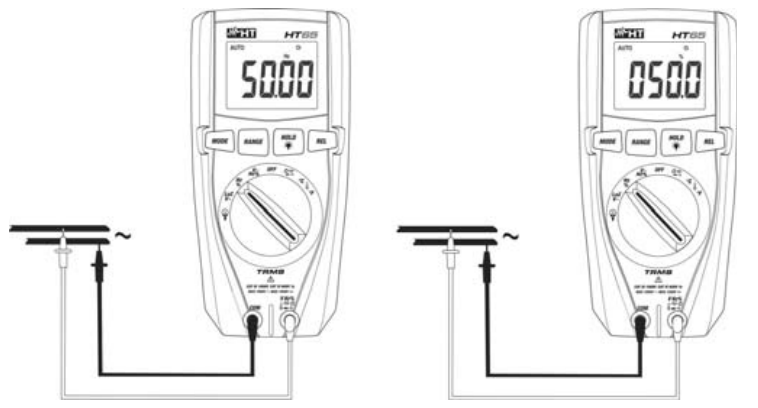 Fig. 5: Use of the instrument for frequency measurement and duty cycle test
Fig. 5: Use of the instrument for frequency measurement and duty cycle test
- Select position Hz%.
- Press the MODE key to select measurements “Hz” or “%” in order to display the values of frequency and duty cycle of input voltage.
- Insert the red cable into input terminal Hz%V: terminal
 and the black cable into input
and the black cable into input - Position the red lead and the black lead respectively in the spots of the circuit to be measured (see Fig. 5). The value of frequency (Hz) or of duty cycle (%) is shown on
the display - To use the HOLD function, see § 4.2
5.5. RESISTANCE MEASUREMENT AND CONTINUITY TEST![]() CAUTION
CAUTION
Before attempting any resistance measurement, cut off the power supply from the circuit to be measured and make sure that all capacitors are discharged, if present.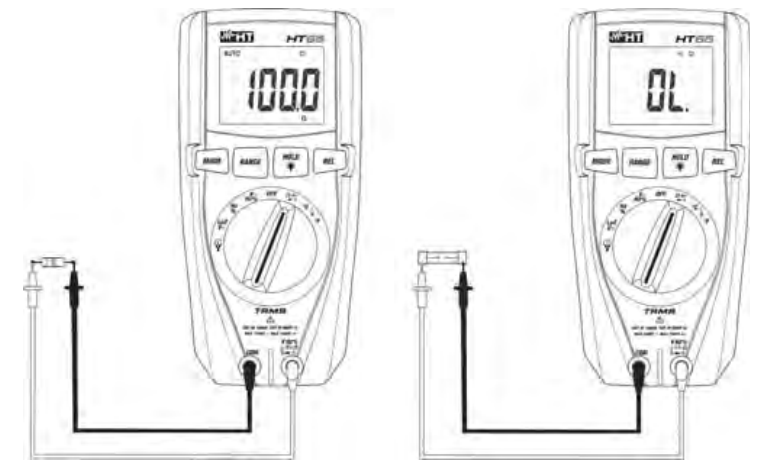 Fig. 6: Use of the instrument for Resistance measurement and Continuity test
Fig. 6: Use of the instrument for Resistance measurement and Continuity test
- Select position :

- . Insert the red cable into input terminal H
 : and the black cable into input terminal COM.
: and the black cable into input terminal COM. - Position the test leads in the desired spots of the circuit to be measured (see Fig. 6).
The display shows the value of resistance. - If the display shows the message “OL”, select a higher range.
- Press the MODE key to select ” ” measurement, relevant to the continuity test, and position the test leads in the desired spots of the circuit to be measured.
- The value of resistance (which is only indicative) is displayed in : and the instrument sounds if the value of resistance is <50: 7. To use the HOLD and RANGE functions, see § 4.2
5.6. DIODE TEST![]() CAUTION
CAUTION
Before attempting any resistance measurement, cut off the power supply from the circuit to be measured and make sure that all capacitors are discharged, if present.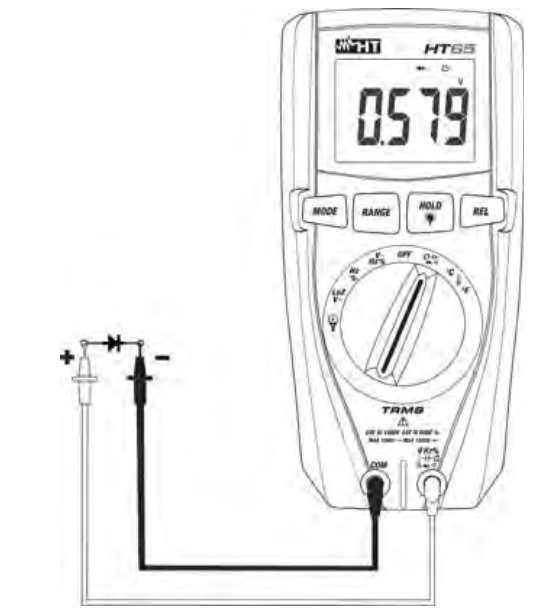 Fig. 7: Use of the instrument for diode test
Fig. 7: Use of the instrument for diode test
- Select position :

- Press the MODE key to select ” ” measurement.
- Insert the red cable into the input terminal
 and the black cable into input terminal COM.
and the black cable into input terminal COM. - Position the leads at the ends of the diode to be tested (see Fig. 7), respecting the indicated polarity. The value of directly polarized threshold voltage is shown on the display.
- If the threshold value is equal to 0mV, the P-N junction of the diode is short-circuited.
- If the display shows the message “OL”, the terminals of the diode are reversed with respect to the indication given in Fig. 7 or the P-N junction of the diode is damaged.
- To use the HOLD function, see § 4.2.
5.7. CAPACITANCE MEASUREMENT![]() CAUTION
CAUTION
Before carrying out capacitance measurements on circuits or capacitors, cut off power supply from the circuit being tested and let all capacitance in it be discharged. When connecting the multimeter and the capacitance to be measured, respect the correct polarity (when required).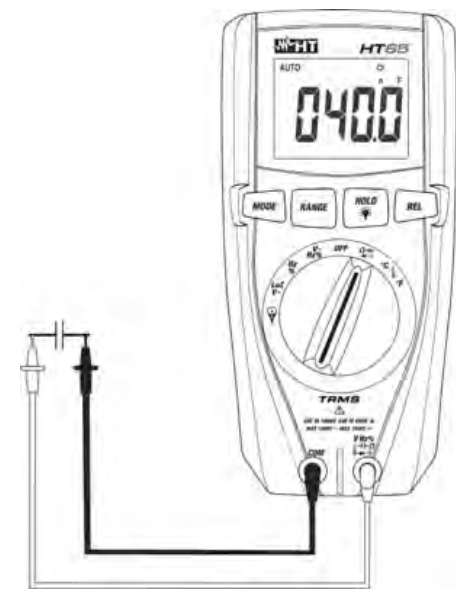
Fig. 8: Use of the instrument for Capacitance measurement
- Select position:

- Press the MODE key until the symbol “nF” is displayed.
- Insert the red cable into input terminal
 : terminal COM. and the black cable into the input
: terminal COM. and the black cable into the input - Long press the REL key before carrying out measurements.
- Position the leads at the ends of the capacitor to be tested, respecting, if necessary, the positive (red cable) and negative (black cable) polarity (see Fig. 8). The display shows the value of capacitance. Depending on the value of capacitance to be measured, the instrument could take approx. The 20s before displaying the final value
- The message “OL.” indicates that the value of capacitance exceeds the maximum measurable value.
- To use the HOLD and REL functions, see § 4.2.
5.8. TEMPERATURE MEASUREMENT WITH K-TYPE PROBE![]() CAUTION
CAUTION
Before attempting any temperature measurement, cut off the power supply from the circuit to be measured and make sure that all capacitors are discharged, if present.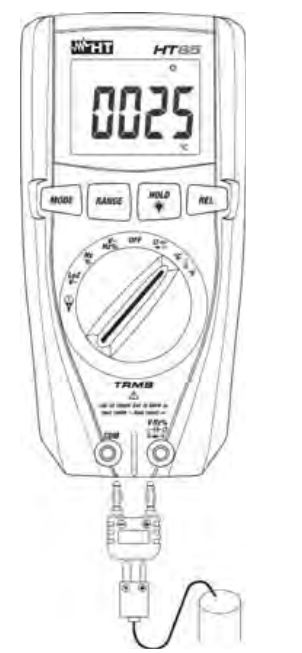 Fig. 9: Use of the instrument for Temperature measurement
Fig. 9: Use of the instrument for Temperature measurement
- Select position °C or position °F
- Insert the provided adapter into input terminals
 : (polarity -) (see Fig. 9) (polarity +) and COM
: (polarity -) (see Fig. 9) (polarity +) and COM - Connect the provided K-type wire probe or the optional K-type thermocouple (see § 7.3.2) to the instrument by means of the adapter, respecting the positive and negative
polarity on it. The display shows the value of the temperature - The message “OL.” indicates that the value of temperature exceeds the maximum measurable value.
- To use the HOLD function, see § 4.2.
5.9. DC CURRENT MEASUREMENT WITH TRANSDUCER CLAMPS![]() CAUTION
CAUTION
- The maximum current measurement in this function is 1000A. Do not measure currents exceeding the limits given in this manual
- The instrument performs the measurement by using standard clamp transducers of HT family. For transducer clamps with Hypertac output connector is necessary the NOCANBA optional adapter in order to perform the connection
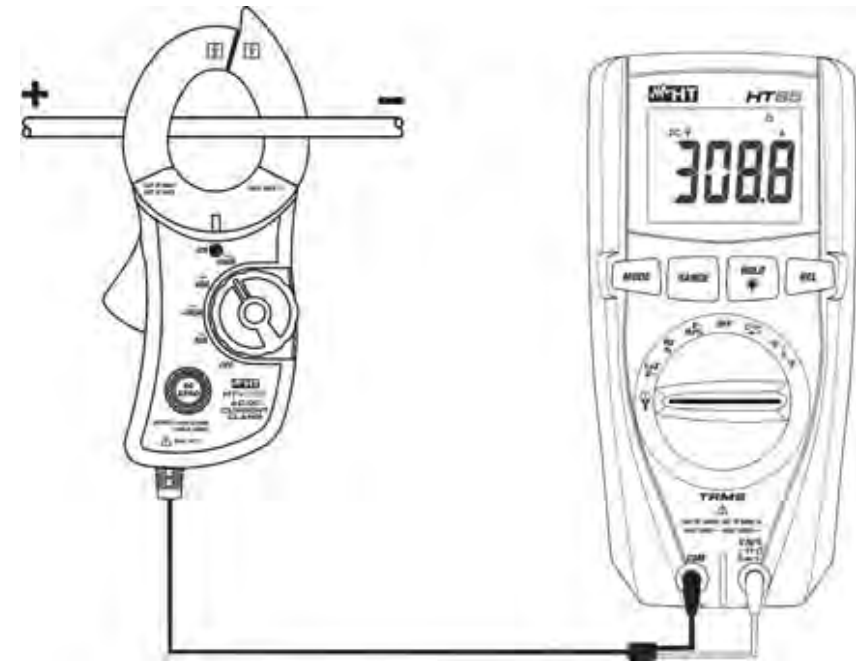
Fig. 10: Use of the instrument for DC current measurement with transducer clamps
- Select position

- Press MODE key to select “DC” measurement
- Press the RANGE key to select on the instrument the same range set on the transducer clamp among the options: 10A, 40A (only HT4006), 100A, 400A (onlyHT4006),1000A.The selected range appear for 2s on the display
- Insert the red cable into input terminal
 : and the black cable into the input terminal COM. For other standard transducers (see § 7.3.2) with Hypertac connector use the NOCANBA optional accessory. For information about the use of a transducer, clamps refer to the relative user manual
: and the black cable into the input terminal COM. For other standard transducers (see § 7.3.2) with Hypertac connector use the NOCANBA optional accessory. For information about the use of a transducer, clamps refer to the relative user manual - Insert the cable inside the jaw (see Fig. 10). The value of current appears on the display
- If the display shows the message “OL”, the maximum measurable value has been reached
- When the symbol “-” appears on the instrument’s display, it means that current has the opposite direction with respect to the connection in Fig. 10
- To use the HOLD, RANGE, and REL functions, see § 4.2
5.10. AC CURRENT MEASUREMENT WITH TRANSDUCER CLAMPS![]() CAUTION
CAUTION
- The maximum current measurement in this function is 3000A. Do not measure currents exceeding the limits given in this manual
- The instrument performs the measurement by using both a flexible transducer clamp (optional accessory F3000U) and other standard clamp transducers of HT family. For transducer clamps with Hypertac output connector is necessary the NOCANBA optional adapter in order to perform the connection

Fig. 11: Use of the instrument for AC current measurement with transducer clamps
- Select position

- Press the RANGE key to select on the instrument the same range set on the transducer clamp among the options: 1000mA,10A, 30A, 40A (only HT4006), 100A,300A, 400A(only HT4006),1000A, 3000A.The selected range appear for 2s on the display
- Insert the red cable into input terminal
 : and the black cable into the input terminal COM. For other standard transducers (see § 7.3.2) with Hypertac connectors use the NOCANBA optional accessory. For information about the use of a transducer, clamps refer to the relative user manual
: and the black cable into the input terminal COM. For other standard transducers (see § 7.3.2) with Hypertac connectors use the NOCANBA optional accessory. For information about the use of a transducer, clamps refer to the relative user manual - Insert the cable inside the jaw (see Fig. 32). The value of the current appears on the display
- Press and hold the MODE key to select measurements “Hz” o “%” in order to display the values of frequency and duty cycle of input current. Press and hold again the MODE key to go back to current measurement
- If the display shows the message “OL”, the maximum measurable value has been reached
- To use the HOLD, RANGE, and REL functions, see § 4.2
MAINTENANCE
![]() CAUTION
CAUTION
- Only expert and trained technicians should perform maintenance operations. Before carrying out maintenance operations, disconnect all cables from the input terminals.
- Do not use the instrument in environments with high humidity levels or high temperatures. Do not expose to direct sunlight.
- Always switch off the instrument after use. In case the instrument is not to be used for a long time, remove the battery to avoid liquid leaks that could damage the instrument’s internal circuits.
6.1. REPLACING BATTERY
When the LCD display shows the symbol “+ -, it is necessary to replace the battery.
- Position the rotary switch to OFF and remove the cables from the input terminals.
- Turn the fastening screw of the battery compartment cover from position “
 ” to position “
” to position “ ” and remove it.
” and remove it. - Remove the battery and insert a new battery of the same type (see § 7.1.2), respecting the indicated polarity.
- Restore the battery compartment cover into place and turn the fastening screw from position ”
 ” to position ”
” to position ”  “.
“. - Do not scatter old batteries into the environment. Use the relevant containers for disposal.
6.2. CLEANING THE INSTRUMENT
Use a soft and dry cloth to clean the instrument. Never use wet cloths, solvents, water, etc.
6.3. END OF LIFE WARNING: the symbol on the instrument indicates that the appliance and its accessories must be collected separately and correctly disposed of.
WARNING: the symbol on the instrument indicates that the appliance and its accessories must be collected separately and correctly disposed of.
TECHNICAL SPECIFICATIONS
7.1. TECHNICAL CHARACTERISTICS
Accuracy calculated as [%reading + (num. digits*resolution)] at 18°C y 28°C <75%RH
DC Voltage
| Range (*) | Resolution | Accuracy | Input impedance | Overload protection |
| 400.0mV | 0.1mV | ±(1.2%rdg + 4dgt) | 10MW | 1500VDC |
| 4.000V | 0.001V | |||
| 40.00V | 0.01V | |||
| 400.0V | 0.1V | |||
| 1500V | 1V | ±(1.5%rdg + 2dgt) |
AC TRMS Voltage
| Range | Resolution | Accuracy (*) (50Hz¸1kHz) | Input impedance | Overload protection |
| 4.000V | 0.001V | ±(1.2%rdg + 10dgt) | 10MW | 1000VDC/ACrms |
| 40.00V | 0.01V | ±(1.5%rdg + 3dgt) | ||
| 400.0V | 0.1V | |||
| 1000V | 1V | ±(2.0%rdg + 4dgt) |
(*) Accuracy specified from 5% to 100% of the measuring range; Frequency range: 50Hz ÷ 1kHz (sinusoidal waveform) For not sinusoidal waveforms the accuracy is: r(10.0%rdg + 10dgt) (50Hz÷60Hz)
DC/AC TRMS Voltage with low impedance (LoZ)
| Range | Resolution | Accuracy (*) | Input impedance | Overload protection |
| 4.000V | 0.001V | ±(3.0%rdg+40dgt) | approx 3kW | 600VDC/ACrms |
| 40.00V | 0.01V | |||
| 400.0V | 0.1V | |||
| 600V | 1V |
(*) Accuracy specified from 5% to 100% of the measuring range; Frequency range: 50Hz ÷ 1kHz (sinusoidal waveform) For not sinusoidal waveforms the accuracy is: r(10.0%rdg + 10dgt) (50Hz÷60Hz)
Diode test
| Function | Resolution | Accuracy | Max voltage with open circuit | Overload protection |
| 1mV | ±(10%rdg+5dgt) | <3VDC | 250VDC/ACrms |
DC Current with transducer clamp
| Range | Output ratio | Resolution | Accuracy (*) | Overload protection |
| 10A | 100mV/1A | 0.01A | ±(1.5%rdg + 6dgt) | 1000VDC/ACrms |
| 40A (**) | 10mV/1A | ±(1.5%rdg + 26dgt) (***) | ||
| 100A | 0.1A | ±(1.5%rdg + 6dgt) | ||
| 400A (**) | 1mV/1A | ±(1.5%rdg + 26dgt) (***) | ||
| 1000A | 1A | ±(1.5%rdg + 6dgt) |
(*) Accuracy referred to only instrument without transducer clamp; (**) With HT4006 transducer; (***) Accuracy instrument + clamp
AC TRMS Current with transducer clamp
| Range | Output ratio | Resolution | Accuracy (*) (50Hz¸1kHz) | Overload protection |
| 1000mA | 1V/1A | 1mA | ±(2.5%rdg + 10dgt) | 1000VDC/ACrms |
| 10A | 100mV/1A | 0.01A | ||
| 30A | ||||
| 40A (**) | 10mV/1A | ±(3.5%rdg + 30dgt) (***) | ||
| 100A | 0.1A | ±(2.5%rdg + 10dgt) | ||
| 300A | ||||
| 400A (**) | 1mV/1A | ±(3.5%rdg + 30dgt) (***) | ||
| 1000A | 1A | ±(2.5%rdg + 10dgt) | ||
| 3000A |
(*) Accuracy referred to only instrument without transducer clamp; Accuracy specified from 5% to 100% of the measuring range (**) With HT4006 transducer; (***) Accuracy instrument + clamp
For not sinusoidal waveforms the accuracy is: r(10.0%rdg + 10dgt)
Resistance and Continuity test
| Range (*) | Resolution | Accuracy | Buzzer | Overload protection |
| 400.0W | 0.1W | ±(1.2%rdg + 4dgt) | <50W | 250VDC/ACrms |
| 4.000kW | 0.001kW | ±(1.0%rdg + 2dgt) | ||
| 40.00kW | 0.01kW | ±(1.2%rdg + 2dgt) | ||
| 400.0kW | 0.1kW | |||
| 4.000MW | 0.001MW | |||
| 40.00MW | 0.01MW | ±(2.0%rdg + 3dgt) |
Frequency (electrical circuits)
| Range (*) | Resolution | Accuracy | Overload protection |
| 10Hz ¸ 10kHz | 0.001Hz÷0.01kHz | ±(1.5%rdg + 5dgt) | 600VDC/ACrms |
Frequency (electronic circuits)
| Range | Resolution | Accuracy | Overload protection |
| 9.999Hz | 0.001Hz | ±(1.5%rdg + 5dgt) | 250VDC/ACrms |
| 99.99Hz | 0.01Hz | ||
| 999.9Hz | 0.1Hz | ±(1.2%rdg + 3dgt) | |
| 9.999kHz | 0.001kHz | ||
| 99.99kHz | 0.01kHz | ||
| 999.9kHz | 0.1kHz | ||
| 9.999MHz | 0.001MHz | ±(1.5%rdg + 4dgt) | |
| 10.00MHz | 0.01MHz |
Duty Cycle
| Range (*) | Resolution | Accuracy |
| 0.5% ¸ 99% | 0.1% | ±(1.2%rdg + 2dgt) |
Pulse frequency range: 5Hz y 10kHz, Pulse duration: 100Ps y 100ms In AC voltage frequency range: 10Hz ÷10kHz, sensitivity >15Vrms
Overload protection
| Range | Resolution | Accuracy | Overload protection |
| 40.00nF | 0.01nF | ±(5.0%rdg + 7dgt) | 250VDC/ACrms |
| 400.0nF | 0.1nF | ±(3.0%rdg + 5dgt) | |
| 4.000mF | 0.001mF | ||
| 40.00mF | 0.01mF | ||
| 400.0mF | 0.1mF | ±(5.0%rdg + 5dgt) | |
| 4.000mF | 0.001mF | ±(10%rdg) | |
| 40.00mF | 0.01mF |
Temperature with K-type probe (Autorange)
| Range | Resolution | Accuracy (*) | Overload protection |
| -20°C ÷ 760°C | 1°C | ±(3.0%rdg + 5°C) | 250VDC/ACrms |
| -4°F ÷ 1400°F | 1°F | ±(3.0%rdg + 9°F) |
(*) Instrument accuracy with no probe
7.1.1.Reference standards
Safety…………………………………………….IEC/EN61010-1
EMC……………………………………IEC/EN 61326-1
Insulation:…………………………………………..double insulation
Pollution level:……………………………………………. 2
Overvoltage category:………………………………….CAT IV 600V, CAT III 1000V to ground
7.1.2 General characteristics Mechanical characteristics
Size (L x W x H)…………………………………….175 x 85 x 55mm (7 x 3 x 2in)
Weight (batteries included):…………………………………………..360g (13 ounces)
Mechanical protection:…………………………………IP40
Power supply
Battery type:………………………………………..1x9V battery type IEC 6F22
Low battery indication:……………………………….symbol “”” on the display
Battery life:………………………………ca.45h (backlight ON), ca 60h (backlight OFF)
Auto Power Off……………………………..after 15 minutes’ idling (can be disabled)
Display
Conversion………………………………TRMS
Characteristics……………………………4 LCD, 4000 dots, decimal sign, point and backlight
Sampling frequency:……………………………………3 times/s
7.1 ENVIRONMENT
7.1.1. Environmental conditions for use
Reference temperature:,,,,,…………………………………..18°C ¸ 28°C (64°F ¸ 82°F)
Operating temperature………………………………………………. 0°C ÷ 40°C (32°F ¸ 104°F)
Allowable relative humidity:……………………………………………………<70%RH
Storage temperature…………………………………………………….-20°C ÷ 60°C (-4°F ¸ 140°F)
Storage humidity:……………………………………………<80%RH
Max operating altitude:…………………………………………….2000m (6562ft)
ACCESSORIES
7.2.1 Accessories provided
- Pair of test leads
- Adapter + K-type wire probe
- Batteries
- ISO9000 calibration certificate
- Carrying bag
- User manual
7.1.1.Optional accessories
- K-type probe for air and gas temperature …………………………………………….Code TK107
- K-type probe for semisolid substance temperature………………………… Code TK108
- K-type probe for liquid substance temperature ………………………………….Code TK109
- K-type probe for surface temperature…………………………………………….. Code TK110
- K-type probe for surface temperature with 90° tip…………………………………. Code TK111
- Flexible transducer clamp AC 30/300/3000A……………………………………………………….. Code F3000U
- Standard transducer clamp AC 1-100-1000A/1V ………………………………………………………Code HT96U
- Standard transducer clamp AC 10-100-1000A/1V …………………………………………………Code HT97U
- Standard transducer clamp DC 1000A/1V ……………………………………………………………..Code HT98U
- Standard transducer clamp AC/DC 40/400A …………………………………………………..Code HT4006
- Adapter for connection of standard clamp with Hypertac connector ……………………………….Code NOCANBA
ASSISTANCE
8.1. WARRANTY CONDITIONS
This instrument is warranted against any material or manufacturing defect, in compliance with the general sales conditions. During the warranty period, defective parts may be replaced. However, the manufacturer reserves the right to repair or replace the product. Should the instrument be returned to the After-sales Service or to a Dealer, transport will be at the Customer’s charge. However, shipment will be agreed in advance. A report will always be enclosed to a shipment, stating the reasons for the product’s return. Only use original packaging for shipment. Any damage due to the use of non-original packaging material will be charged to the Customer. The manufacturer declines any responsibility for injury to people or damage to property.
The warranty shall not apply in the following cases:
- Repair and/or replacement of accessories and battery (not covered by warranty).
- Repairs that may become necessary as a consequence of incorrect use of the instrument or due to its use together with non-compatible appliances.
- Repairs that may become necessary as a consequence of improper packaging. x Repairs which may become necessary as a consequence of interventions performed
by unauthorized personnel. - Modifications to the instrument performed without the manufacturer’s explicit authorization.
- Use not provided for in the instrument’s specifications or in the instruction manual.
The content of this manual cannot be reproduced in any form without the manufacturer’s authorization.
Our products are patented and our trademarks are registered. The manufacturer reserves the right to make changes in the specifications and prices if this is due to improvements in technology.
8.2. ASSISTANCE
If the instrument does not operate properly, before contacting the After-sales Service, please check the conditions of battery and cables and replace them, if necessary. Should the instrument still operate improperly, check that the product is operated according to the instructions given in this manual. Should the instrument be returned to the After-sales Service or to a Dealer, transport will be at the Customer’s charge. However, shipment will be agreed in advance. A report will always be enclosed to a shipment, stating the reasons for the product’s return. Only use original packaging for shipment; any damage due to the use of non-original packaging material will be charged to the Customer.
Documents / Resources
 | HT HT65 TRMS Digital Multimeter [pdf] User Manual HT65, TRMS Digital Multimeter |



